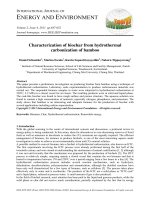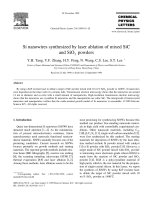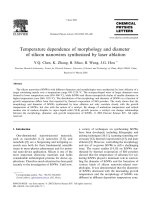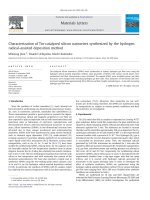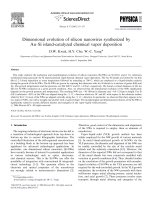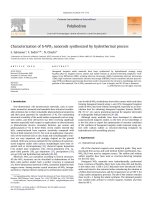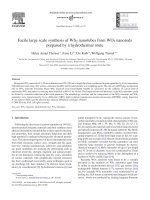- Trang chủ >>
- Khoa Học Tự Nhiên >>
- Vật lý
characterization of h - wo3 nanorods synthesized by hydrothermal process
Bạn đang xem bản rút gọn của tài liệu. Xem và tải ngay bản đầy đủ của tài liệu tại đây (681.09 KB, 5 trang )
Characterization of h-WO
3
nanorods synthesized by hydrothermal process
S. Salmaoui
a
, F. Sediri
a,b,
*
, N. Gharbi
a
a
Laboratoire de Chimie de la Matière Condensée, IPEIT, Université de Tunis, 2 rue Jawaher Lel Nehru 1008, B.P. 229 Montfleury, Tunis, Tunisia
b
Faculté des Sciences de Tunis, Université Tunis-Elmanar, 2092 Elmanar, Tunis, Tunisia
article info
Article history:
Received 10 November 2009
Accepted 15 February 2010
Available online 19 February 2010
Keywords:
Tungsten oxide
Aniline
Hydrothermal synthesis
Nanorods
abstract
Hexagonal tungsten oxide nanorods have been synthesized by hydrothermal strategy using
Na
2
WO
4
Á2H
2
O as tungsten source, aniline and sulfate sodium as structure-directing templates. Tech-
niques X-ray diffraction (XRD), scanning electron microscopy (SEM), transmission electron microscopy
(TEM), high-resolution transmission electron microscopy (HRTEM), Fourier transform infrared spectros-
copy (FTIR) and Raman spectroscopy have been used to characterize the structure, morphology and com-
position of the nanorods. The h-WO
3
nanorods are up to 5
l
m in length, and 50–70 nm in diameter.
Ó 2010 Elsevier Ltd. All rights reserved.
1. Introduction
One-dimensional (1D) nanostructure materials, such as nano-
tubes, nanowires, nanorods and nanobelts have attracted consider-
able attention due to their remarkable physicochemical properties
and their great potential for nanodevices [1–6]. The outstanding
structural versatility of the metal oxides compounds such as tung-
sten oxides, and their derivatives has been receiving significant
attention especially with respect to applications in electrochromic
or photochromic devices, secondary batteries, gas sensors and
photocatalysts [7–9]. In these fields, recent studies showed that
WO
3
nanostructured have superior sensitivity compared with
those of bulk materials [10,11]. For such an application, character-
istics of the material such as size, shape and crystallographic struc-
ture are very important and strongly depend on the growth
method. Until now various methods for the synthesis of nanostruc-
tured tungsten oxides with various morphologies have been re-
ported such as electrospinning [12], chemical vapour deposition
[13], pulsed laser irradiation [14], electro-deposition [15], va-
pour–solid growth [16], gas deposition [17], precipitation [18],
sol–gel [19] and hydrothermal methods [20–24].
Moreover, WO
3
can crystallize according to several structures.
All the WO
3
structures can be described as deformations of the
ReO
3
cubic perfect model. Such a perfect structure is composed
of a three-dimensional network of WO
6
octahedral linked by their
oxygen corner. Among various crystal structures of WO
3
, hexago-
nal form is of great interest owing to its well-known tunnel struc-
ture in which WO
6
octahedrons share their corners with each other
forming hexagonal tunnels along c-axis [25]. Hexagonal tungsten
oxide (h-WO
3
) has been widely investigated, especially as an inter-
calation host for obtaining hexagonal tungsten bronzes MxWO
3
(M = K
+
,Li
+
, etc.) and a promising material for negative electrodes
of rechargeable lithium batteries [26–28].
Although many methods have been developed to elaborate
nanostructured tungsten oxides, to the best of our knowledge, it
is the first time to report the optimization of reaction conditions
of the synthesis of hexagonal tungsten oxide nanorods using ani-
line with sodium sulfate as structure-directing templates by
hydrothermal self-assembling process.
2. Experimental
2.1. Hydrothermal synthesis
All of the chemical reagents were analytical grade. They were
purchased from across and used without further purification. Na
2
-
WO
4
Á2H
2
O was used as tungsten source. The aniline and sodium
sulfate together have been used as structure-directing template
for the first time.
Hexagonal WO
3
nanorods were hydrothermally synthesised
from a mixture of Na
2
WO
4
Á2H
2
O, H
2
O, C
6
H
5
–NH
2
, HCl and Na
2
SO
4
in the molar ratio 1:258:1:2.8:5. Reactants were introduced in this
order and stirred a few minutes before introducing the solution in
a Teflon-lined steel autoclave and the temperature set at 180 °C for
3 days under autogenous pression. The pH of the solution remains
close to pH % 1 during the whole synthesis. The obtained powder
was washed with acetone to remove organics residues and then
dried at 80 °C.
0277-5387/$ - see front matter Ó 2010 Elsevier Ltd. All rights reserved.
doi:10.1016/j.poly.2010.02.025
* Corresponding author. Address: Faculté des Sciences de Tunis, Université Tunis-
Elmanar, 2092 Elmanar, Tunis, Tunisia. Tel.: +216 71872600; fax: +216 71871666.
E-mail addresses: (F. Sediri),
(N. Gharbi).
Polyhedron 29 (2010) 1771–1775
Contents lists available at ScienceDirect
Polyhedron
journal homepage: www.elsevier.com/locate/poly
In order to control the morphology of h-WO
3
a set of experi-
ments was performed by varying the molar ratio Na
2
SO
4
:W from
0.15:1 to 5:1.
2.2. Characterization techniques
X-ray diffraction (XRD) patterns were obtained on a X‘Pert Pro
Panalytical diffractometer with Co K
a
radiation (k = 1.78901 Å).
The XRD measurements were carried out by a step scanning meth-
od (2h range from 3° to 60°), the scanning rate is 0.03°/s and the
step time is 3 s.
Scanning electron microscopy (SEM) images were obtained
with a Cambridge Instruments Stereoscan 120.
Transmission electron microscopy (TEM) studies were recorded
on JEOL 100 CX II electron microscope operated at 200 KV. One
droplet of the powder dispersed in CH
3
CH
2
OH was deposited onto
a carbon-coated copper grid and left to dry in air.
Fourier transform infrared spectra (FTIR) were recorded with a
Nicolet 380 Spectrometer.
Raman spectroscopy was performed using a Jobin Yvon T 64000
Spectrometer.
3. Results and discussion
3.1. X-ray diffraction
By controlling the appropriate molar ratio of the starting mate-
rials (Na
2
SO
4
:W), the nanorods can be prepared conveniently with
high purity. Fig. 1 shows the XRD patterns of the as-obtained prod-
ucts at different molar ratio Na
2
SO
4
:W = (a) 5:1, (b) 2.5:1, (c)
1.25:1, (d) 0.62:1 (e) 0.30:1 and (f) 0.15:1, respectively. All the dif-
fraction peaks can be perfectly indexed to hexagonal tungsten
oxide crystalline phase (h-WO
3
) with lattice constants of
a = 7.298 Å and c = 3.899 Å (JCPDS # 33-1387). The peak intensities
in the reported spectra were not exactly the same as the reference
spectrum because of differences in the molar ratio. No peaks of any
other phases or impurities were observed from the XRD patterns,
indicating that h-WO
3
crystalline phase with high purity could
be obtained using the present synthetic process.
3.2. Scanning and transmission electronic microscopy
To understand the formation of the rod-like morphology, we
conducted the experiment in the presence of different amount of
Na
2
SO
4
while keeping other conditions unchanged. The morphol-
ogy of the products was investigated by SEM and TEM images. It
is found that the amount of Na
2
SO
4
has clear effects on the forma-
tion of nanorods. Comparative experiments have shown that when
the molar ratio Na
2
SO
4
:W = 0.62:1, only irregular particles of nano-
rods and nanowires were formed (Fig. 2a). With increasing the mo-
lar ratio to 1.25:1, nanorods were generated with an increase in the
diameter (Fig. 2b). When the molar ratio = 2.5:1 the h-WO
3
rod-
like nanostructures became predominant products (Fig. 2c).
SEM and TEM images, shown in Fig. 2d and e, indicate that with
aNa
2
SO
4
:W ratio of 5:1, a rod-like structure with diameters of
about 50–70 nm and length of about 5
l
m were obtained. Close
observation shown in Fig. 2f revealed that these rod-shape prod-
ucts are formed by the oriented attachment of large, numerous,
highly aligned, and closely packed nanoneedles. According to the
literature [29], sodium sulfate tends to induce the formation of
the 1D nanostructures of h-WO
3
. Thus, the size and the yield of
the rod-like nanostructures increase with increasing the amount
of the salt. As a result, the presence of an appropriate amount of
Na
2
SO
4
plays a key role in the formation of the h-WO
3
nanorods
evolved from the oriented attachment of h-WO
3
nanoneedles.
Controlled experiments have shown that the presence of aniline
without Na
2
SO
4
, only irregular particles coexist with a small frac-
tion of nanoneedles of orthorhombic WO
3
Á1/3H
2
O (JCPDS # 35-
0270) (Figs. 3a and 4a) were obtained. Furthermore, when the
preparations are made without aniline and sodium sulfate only
regular plate-like of monoclinic WO
3
(JCPDS # 72-1465) are
formed (Figs. 3b and 4b). Our results show that the addition of so-
dium sulfate without aniline leads to the formation of irregular
nanoneedles of the h-WO
3
(Fig. 5).
As reported in the literature, organic molecules were found to
play an important role in the controlling the morphologies. Thus,
it appears that aniline, due to its anisotropic character, is used as
capping agent which induce and enhance the directing role of
Na
2
SO
4
in the formation of 1D h-WO
3
nanostructures [24,30,31].
In view of these results, we can conclude that aniline and so-
dium sulfate play important roles on the types of structure, mor-
phology and size of particles constituting the product.
The details of the effect of sulfate on the formation of WO
3
nanocrystal are not clear up to date. However, it is known that
the anisotropic growth of the particles can be explained by the spe-
cific adsorption of ions to particular crystal surface, therefore,
inhibiting the growth of these faces by lowering their surface en-
ergy [32,33].
This study allowed us to determine the optimum conditions of
synthesis of h-WO
3
nanoneedles. Indeed, the observation by SEM
(Fig. 2d) of the obtained product with the molar ratio Na
2
SO
4
:Na
2
-
WO
4
= 5:1 shows that the synthesized material is made of homog-
enous phase with uniform particles which display nanorods mor-
phology sizing about 5
l
m in length. TEM image (Fig. 2e) shows
that the as-synthesized product exhibits the same rod-like mor-
phology. These nanorods are straight and uniform in diameter in
the range of 50–70 nm.
The high-resolution HRTEM image in Fig. 6, clearly, reveals that
the inter-plane distance is 0.383 nm. This could be indexed as
[001] of the h-WO
3
crystal, according to JCPDS # 33-1387. This re-
sult is good agreement with X-ray diffraction.
3.3. Infrared spectroscopy
The structure information was further provided by FTIR spec-
troscopy. Fig. 7 displays the FTIR spectrum of as-synthesized WO
3
Fig. 1. XRD patterns of h-WO
3
synthesized at different molar ratio Na
2
SO
4
:W (a)
5:1, (b) 2.5:1, (c) 1.25:1, (d) 0.62:1 (e) 0.30:1 and (f) 0.15:1.
1772 S. Salmaoui et al. /Polyhedron 29 (2010) 1771–1775
nanorods. The broad band located between 949 and 870 cm
À1
ob-
served for the WO
3
is present in many tungsten oxide compounds.
It is attributed to the stretching of short W@O bonds that are
also present in h-WO
3
, while the bands located at 817 and
728 cm
À1
are assigned to O–W–O stretching modes [34]. The
vibrational bands centered at 659 and 590 cm
À1
are attributed to
W–O–W stretching modes [35].
3.4. Raman spectroscopy
Raman spectroscopy was used to characterize this material
since this technique is suitable to obtain details of the WO
3
chem-
ical structure (Fig. 8). Well defined peaks centered at 236, 265, 328,
612, 702 and 807 cm
À1
, can be observed. According to the litera-
ture [35,36], these bands can be assigned to the fundamental
modes of crystalline h-WO
3
. The bands at 807 and 702 cm
À1
are
attributed to the symmetric and asymmetric vibrations of W
6+
–O
bonds (O–W–O stretching modes), while the bands at 328, 265
and 236 cm
À1
can be attributed to the W–O–W bending mode of
the bridging oxygen. The band at 460 cm
À1
can be attributed to
the characteristic band of crystalline WO
3
[37–39]. FTIR and Ra-
man results confirm those obtained by X-ray diffraction.
This study suggests to propose a mechanism for the formation
processes of h-WO
3
nanorods under hydrothermal conditions:
Fig. 2. SEM images for the products prepared at different molar ratio Na
2
SO
4
:W (a) 0.62:1, (b) 1.25:1, (c) 2.5:1 and (d) 5:1. TEM images for the products prepared at molar
ratio Na
2
SO
4
:W (e) and (f) 5:1.
S. Salmaoui et al. /Polyhedron 29 (2010) 1771–1775
1773
Fig. 3. SEM images of the as-obtained materials: (a) with aniline and without
sodium sulfate (b) without sodium sulfate and aniline.
Fig. 4. XRD patterns of the as-obtained materials: (a) without sodium sulfate (b)
without sodium sulfate and aniline.
Fig. 5. SEM image of the as-obtained material in presence of Na
2
SO
4
only.
Fig. 6. HRTEM image of the individual WO
3
nanorod.
Fig. 7. IR spectrum of h-WO
3
nanorods.
1774 S. Salmaoui et al. /Polyhedron 29 (2010) 1771–1775
Na
2
WO
4
þ 2HCl þ nH
2
O ! H
2
WO
4
ÁnH
2
O þ 2NaCl ð1Þ
H
2
WO
4
ÁnH
2
O
!
Hydrothermal treatment
C
6
H
5
—NH
2
þNa
2
SO
4
WO
3
þðn þ 1ÞH
2
O ð2Þ
In this treatment, with sufficient energy provided by the hydro-
thermal system, the WO
3
nuclei were formed. In the presence of
aniline and Na
2
SO
4
, these nuclei serve as seeds and following grow
along the c-axis direction of h-WO
3
unit cell due to the aniline and
sulfate preferentially absorb on the faces parallel to the c-axis of
the WO
3
, resulting in the formation of the nanorods. More in-depth
studies are necessary to further understand their growth process,
which can provide important information for structure design
and morphology controlled synthesis of oxides.
4. Conclusion
In summary, we have successfully synthesized h-WO
3
nanorods
through a hydrothermal process. The h-WO
3
nanorods are up to
some
l
m in length, and 50–70 nm in diameter. The pure hexagonal
phase crystalline WO
3
nanostructure was confirmed by XRD, SEM,
TEM, HRTEM, IR and Raman analyses. The formation of nanorods
greatly relies on the presence of aniline and sodium sulfate. Be-
sides, a particular amount of sodium sulfate in the reaction med-
ium plays a critical role even though the presence of aniline
required for producing the morphology of rod-like structure of
WO
3
. This versatile method provides a straightforward and effi-
cient means of obtaining WO
3
nanostructure having unique mor-
phology. Furthermore, this synthetic method is simple, mild, and
controllable, and it provides a novel method for direct solution
growth of highly oriented and hierarchical nanostructures. Indeed,
we anticipate that this technique can be exploited for the fabrica-
tion of other nanomaterial oxides.
Acknowledgements
We would like to acknowledge Prof. M. Ben Salem, Faculté des
Sciences de Bizerte, for TEM studies and Prof. M. Oueslati, Faculté
des Sciences de Tunis, for Raman experiments.
References
[1] S. Iijima, Nature 354 (1991) 56.
[2] A.M. Morales, C.M. Lieber, Science 279 (1998) 208.
[3] P.M. Ajayan, O. Stephan, P. Redlich, C. Colliex, Nature 375 (1995) 564.
[4] M.E. Spahr, P. Bitterli, R. Nesper, M. Muller, F. Krumeich, H.U. Nissen, Angew.
Chem. 110 (1998) 1339.
[5] M. Niederberger, F. Krumeich, H.J. Muhr, M. Muller, R. Nesper, J. Mater. Chem.
11 (2001) 1941.
[6] L.Q. Mai, W. Chen, Q. Xu, Q.Y. Zhu, C.H. Han, J.F. Peng, Solid State Commun. 126
(2003) 541.
[7] X.L. Li, T.J. Lou, X.M. Xiao, Y.D. Li, Inorg. Chem. 43 (2004) 5442.
[8] T. He, Y. Ma, Y.A. Cao, X.L. Hu, H.M. Liu, G.J. Zhang, W.S. Yang, J.N. Yao, J. Phys.
Chem. B 106 (2002) 12670.
[9] M. Hibino, W. Han, T. Kudo, Solid State Ionics 135 (2000) 61.
[10] J. Tamaki, A. Hayashi, Y. Yamamoto, M. Matsuoka, Sens. Actuators B 95 (2003)
111.
[11] M. Gillet, K. Aguir, C. Lemire, E. Gillet, K. Schierbaum, Thin Solid Films 467
(2004) 239.
[12] X. Lu, X. Liu, W. Zhang, C. Wang, Y. Wei, J. Colloid Interface Sci. 298 (2006) 996.
[13] X.P. Wang, B.Q. Yang, H.X. Zhang, P.X. Feng, Nanoscale Res. Lett. 2 (2007) 405.
[14] E. Haro-Poniatowski, M. Jouanne, J.F. Morhange, C. Julien, R. Diamant, M.
Fernández-Guasti, G.A. Fuentes, J.C. Alonso, Appl. Surf. Sci. 127–129 (1998)
674.
[15] M. Deepa, A.K. Srivastava, S. Lauterbach, S.M. Govind Shivaprasad, K.N. Sood,
Acta Mater. 55 (2007) 6095.
[16] M. Gillet, K. Mazek, V. Potin, S. Bruyère, B. Domenichini, S. Bourgeois, E. Gillet,
V. Matolin, J. Cryst. Growth 310 (2008) 3318.
[17] L.F. Reyes, S. Saukko, A. Hoel, V. Lantto, C.G. Gransqvist, J. Eur. Ceram. Soc. 24
(2004) 1415.
[18] O. Nimittrakoolchai, S. Supothina, J. Mater. Chem. Phys. 112 (2008) 270.
[19] A. Patra, K. Auddy, D. Ganguli, J. Livage, P.K. Biswas, Mater. Lett. 58 (2004)
1059.
[20] S.J. Yoo, Y.H. Jung, J.W. Lim, H.G. Choi, D.K. Kim, Y.E. Sung, Sol. Energy Mater.
Sol. Cells 92 (2008) 179.
[21] Z. Xiao, L. Zhang, Z. Wang, Q. Lu, X. Tian, H. Zeng, Mater. Lett. 61 (2007) 1718.
[22] X.C. Song, Y.F. Zheng, E. Yang, Y. Wang, Mater. Lett. 61 (2007) 3904.
[23] J.M. Wang, E. Khoo, P.S. Lee, J. Ma, J. Phys. Chem. C 112 (2008) 14306.
[24] Z.J. Gu, T.Y. Zhai, B.F. Gao, X.H. Sheng, Y.B. Wang, H.B. Fu, Y. Ma, J.N. Yao, J. Phys.
Chem. B 110 (2006) 23829.
[25] J.D. Guo, K.P. Reis, M.S. Whittingham, Solid State Ionics 53–56 (1992) 305.
[26] K.P. Reis, A. Ramanan, M.S. Whittingham, Chem. Mater. 2 (1990) 219.
[27] K.P. Reis, A. Ramanan, M.S. Whittingham, J. Solid State Chem. 96 (1992) 31.
[28] N. Kumagai, Y. Umetzu, K. Tanno, J.P.P. Ramos, Solid State Ionics 86–88 (1996)
1443.
[29] K. Huang, Q. Pan, F. Yang, S. Ni, X. Wei, D. He, J. Phys. D: Appl. Phys. 41 (2008)
155417.
[30] J.H. Ha, P. Muralidharan, D.K. Kim, J. Alloys Compd. 475 (2009) 446.
[31] F. Sediri, F. Toauti, N. Gharbi, Mater. Sci. Eng. B 129 (2006) 251.
[32] Z.D. Xiao, L.D. Zhang, X.K. Tian, X.S. Fang, Nanotechnology 16 (2005) 2647.
[33] K. Lee, W.S. Seo, J.T. Park, J. Am. Chem. Soc. 125 (2003) 3408.
[34] T. Nishide, F. Mizukami, Thin Solid Films 259 (1995) 212.
[35] M.F. Daniel, B. Desbat, J.C. Lassegues, B. Gerand, M. Figlarz, J. Solid State Chem.
67 (1987) 235.
[36] G.L. Frey, A. Rothschild, J. Sloan, R. Rosentsveig, R. Popovitz-Biro, R. Tenne, J.
Solid State Chem. 162 (2001) 300.
[37] R. Solarska, B.D. Alexander, J. Augustynski, J. Solid State Electrochem. 8 (2004)
748.
[38] I.M. Szilàgyi, J. Madaràsz, G. Pokol, P. Király, G. Tárkányi, S. Saukko, J. Mizsei, A.
Toet, A. Szabo, K. Varga-Josepovits, Chem. Mater. 20 (2008) 4116.
[39] S.W. Song, I.S. Kang, Sens. Actuators B 129 (2008) 971.
Fig. 8. Raman spectrum of h-WO
3
nanorods.
S. Salmaoui et al. /Polyhedron 29 (2010) 1771–1775
1775
